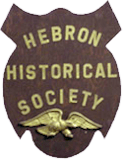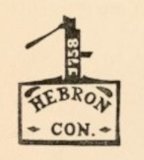
The Hebron Historical Society
Hebron, Connecticut
Enjoy Hebron - It's Here To Stay ™


Enjoy Hebron - It's Here To Stay ™

Map of Historic Diversity and Archeological Sites
Circa 12,500 years before present through 1900 CE
Hebron, Connecticut
This includes African Americans, Indigneus, Ethnic Groups, People with Disabilities, Archeological and Historic Sites, Hebron Center, and Educational

1 - John and Mary (1698-1784) Peters’ House site c1727, location where Cesar Peters grew up and which Pomp Mundo rented in the 1790’s. (Hebron land Records, Kenneth Cameron, Writings of Rev. Samuel Peters)
2 - Approximate location of Widow Abigail Peters’ blacksmith shop where Cesar Peters (c 1760-1814) family lived in 1783. (Bruce Clouette, 2005 Peters House study, Jonathan Peters 1812 inventory.)
3 - Burnt Hill Park – birthplace of John Thompson Peters (b.1764) founder of the Hartford Auxiliary Colonization Society. Also, where “Blind Brett” lived. Distillery for apples and molasses for West Indian trade (Wikipedia, Samuel Peters, History of Hugh Peters, Clouette 2005 Peters House study)
4 - Site of Rev. Samuel Peters’ house (existing ell may have been part of Rev. Peters dwelling, part of his plantation of 600 tilled acres. (Susan Pendleton Rockville Leader History of Hebron series, Rev. Samuel Peters claim for reimbursement)
5 - Possible site of Cesar Peters’ (1760-1814) abduction (1787) (Shipman Farm) (Manuscript of Rev Samuel Peters’ letters to Nathaniel Mann, transcribed by F.C Bissell)
6 - Godfrey Hill Burial Ground location of first St. Peters’ Church (c-1735-1825) where Cesar Peters, Pomp Mundo and other enslaved individuals worshiped (Pendleton Rockville Leader, History of Hebron series)
7 - House occupied by African American Charles Morgan’s (1807—1885) family (Hebron land records)
8 - Site of Harry Peter’s house (Beer’s 1870 map of Hebron)
9 - Site where Lude Barber’s (d 1854) family lived (Hebron Land Records)
10 - Site where Henry (d 1862) and his son Horace Peters (d 1881) had their farm (Hebron land records)
11 - Daniel Horsford Junior owner of Rose and Prince 1773 (Rose and Brown, Black Roots in Southeastern Connecticut 1640-1900)
12 - Site of Cesar and Sim Peters’ house 1806-1815 and (d 1815) (Hebron land Records, Joan Rowley manuscript)
13 - Site where Benjamin Burnham employed African American farmers (Federal Census)
14 - Site of Samuel Gilbert’s (d 1760) house and his African American slaves (Hebron land records, Sylvester Gilbert autobiography, Rose and Brown)
15 - Gilead Congregational Church (records include several African American congregants) (Rose and Brown)
16 - Leverett Peters (d 1888) home, grandson of Cesar Peters. (Beer’s 1870 Hebron map)
17 - Governor Peters’ Barber Farm employing African Americans to build stonewalls and farm land for West Indian, New York City, Boston livestock trade. (John S. Peters manuscripts)
18 - Governor Peters’ (1772-1858) house built in 1806 – where Ezekiel Skinner (1777-1885) founder of Liberia studied. Gov. Peters along with Sylvester Gilbert was one of the most frequent employers of free African Americans in Hebron Center. He was President of Connecticut Colonization Society. (Wikipedia, J S Peters account book)
19 - Original location of Gull school where African- American Charles Profit (b 1830) attended school in the early 19th century (Beer’s 1870 Hebron map)
20 - Northum farm site where African American Charles Profit lived (Rose and Brown, Hebron land records)
21 - Location of Joseph Waters’ farm where enslaved African American Fortune (d 1801) married Sybil (d 1805) in 1799.(Rose and Brown, Hebron land records)
22 - Oldest burial ground with African Americans buried at the rear (Susan Pendleton Rockville Leader)
23 - Location of first settler William Shipman House, oldest house site in Hebron (Hebron, Conn Bicentennial)
24 - Location of Town sign post de facto Hebron Center (Hebron, Conn Bicentennial, Manuscript David Barber’s History of Hebron Antiquities)
25 - Birthplace of historian Benjamin Trumbull (1735-1820) (Susan Pendleton Rockville Leader)
26 - First Euro American encampment site (Susan Pendleton Rockville Leader)
27 - Approximate location of Hebron’s Block House (Susan Pendleton Rockville Leader)
28 - French Troop encampment site 1781 (John Sibun, Our Town’s Heritage)
29 - First Meeting House site ( Susan Pendleton Rockville Leader)
30 - Hendee’s store (possible underground railroad association and where the 1882 Fire began) (Susan Pendleton Rockville Leader)
31 - Militia Training ground (manuscript of Charlotte Morgan Mann Phelps)
32 - 19th century Town Pound (Hebron Tricentennial map)
33 - Godfrey Hill (Hebron “pump” firing site / Anglican church) (Susan Pendleton Rockville Leader)
34 - Site of The Hebron Elm, 1763 – 1904 (Hebron, Conn, Bicentennial)
35 - John Graves cabinet shop site (Hebron land records)
36 - Site where Connecticut Missionary Society was organized (Hebron, Conn Bicentennial)
37 - Lecture House site (Beer’s 1870 map of Hebron)
38 - Congregational Parsonage (Delia Hills scrapbook, Hebron Records)
39 - St Peters’ parsonage (Hebron, Conn Bicentennial)
40 - Hebron Library Association 1888 (Hebron Connecticut Bicentennial)
41 - Iron Foundry site 1835 (Richard Symmond Lost Mills of Hebron Connecticut)
42 - Stonewall laneways 1800 – 1835 built by center village African American day laborers (Robert Thorson, State Geologist, conversation )
43 - Hope Valley School site, ca.1790 – 1949 (Geoff Kirkham email)
44 - H.O. White Store site (Geoff Kirkham email)
45 - Samuel S. Norton homestead site (Geoff Kirkham email)
46 - Hope Valley Blacksmith Shop site (Geoff Kirkham email)
47 - Hope Valley Church (Geoff Kirkham email)
48 - Foundation of the Lamb Sisters home, later owned by Joshua Sayles (ca.1852-1898), an African American farmer. (Mary-Ellen Gonci correspondence)
49 - Hebron Ax Factory site (Lost mills of Hebron, Connecticut, Susan Pendleton Rockville Leader)
50 - Holbrook Pond Saw Mill and Dr. Zalmon Jacobs Pill Factory site (Andrea Latanzi, Lost Mills of Hebron Connecticut)
51 - Site of original Congregational Church where enslaved and manumitted African Americans worshipped (Susan Pendleton Rockville Leader)
52- Gull School African American Charles Profit (b 1830) went to school (Rose and Brown, Henretta Green conversation)
53 - Joel Jones House site whose slave Rev. Peters met in London, 1774- 1780s. Also, site where Chinese Education Mission students lived in the 1870’s (Susan Pendleton Rockville Leader, Manuscript “Letters of Rev. Samuel Peters, Edward Rhodes Stepping Forth into the World)
54 - Timothy Dutton House slave owning family, ca. 1790s ( Susan Pendleton Rockville Leader)
55 - Sylvester Gilbert’s house owner of Primus and Chloe, 1777 - 1800s. (Sylvester Gilbert autobiography, Rose and Brown)
56 Fullers Tavern site largest employer of African Americans (Federal census)
57 - Center school where children of Cesar Peters Junior attended, 1790s - 1800s. (Rose and Brown)
58 - St Peter’s cemetery – grave of Rev. Samuel Peters (1735-1826), owner of Cesar Peters and Pomp Mundo families and Gov. John S. Peters (1777-1858) President of the Connecticut Colonization Society. (Grave monument in St. Peters’ cemetery, Wikipedia)
59 - Burnt Hill Paleo-Indian c 10,000 BP to 18th century (Sarah Sportman, Connecticut State Archaeologist, Charlotte Morgan Mann Phelps projectile points)
60 - Prophet’s Rock Indigenous landmark ( Susan Pendleton Rockville Leader)
61 - Hebron Center site where Susan Pendleton and her father Dr. Cyrus Pendleton collected projectile points (Conversation with Horace Sellers)
62 - Mint Brook Indigenous encampment (Sarah Holmes conversation)
63 - Location of Indigenous trail ( Susan Pendleton Rockville Leader)
64 - Amston Lake evidence of early Woodland pottery (Joan Toomey conversation)
65 - Projectile Point found at Cesar and Sim Peters’ site (Sarah Sportman, Connecticut State Archaeologist)
66 - Tradition location of a community corn quern / grind stone. (Horace Sellers conversation)
67 - Lithic Rhyolite and Quartz flakes and three Indigenous tool fragments found during 2005 archeological dig. (Phase 1 and 2 archaeological study related to John E. Horton Boulevard (Brian Jones, Bruce Clouette)
68 - Two quartz lithics found during 2022 archeological dig. (Sarah Holmes archaeological study report)
69 - Gilead – Italian (Federal census, Hart Buell map)
70 - Burnt Hill –Polish, Slovak (Federal census, Hart Buell map)
71 - Hebron Center- Jewish (Federal census, hart Buell map)
72 - Burrows Hill – Polish and Eastern European (Federal census, Hart Buell map)
73 - Amston- Irish, German (Federal census)
74 - John Howey’s House, earliest Irish immigrant house in Hebron (Mary Ann Foote, Federal census)
75 - William Annable, 1840s (manuscript, Letters of William Annable)
76 - Sylvester Gilbert's (1755-1846?) five deaf children (Sylvester Gilbert autobiography)
77 - William Pitt Gilbert (b 1787) furniture workshop site (Hebron land records)
78 - Kollock family (Federal census, Beer’s 1870 map of Hebron)
79 - Lydia Strong (b 1781) (Phelps family genealogy)
80 - Location of Chinese Educational Mission sites (1870’s) (Edward Rhodes Stepping Forth into the World)
81 - St. Peter’s Summer School (early 20th century) (Austin Warren Becoming what one is)
82 - Benjamin Pomeroy sponsor with Eleazer Wheelock of Moor’s Charity School which became Dartmouth College (Susan Pendleton Rockville Leader)
83 - Site of Sylvester Gilbert’s law school and music school (Susan Pendleton Rockville Leader)
84 - Miss Bradford’s Academy (1835) (Hebron House Tour Brochure)
85 - Amos Bassett House (1806) – Second Principal of the Foreign School in Cornwall (John Demos The Heathen School, Hebron, Conn Bicentennial)